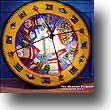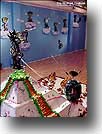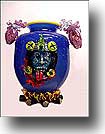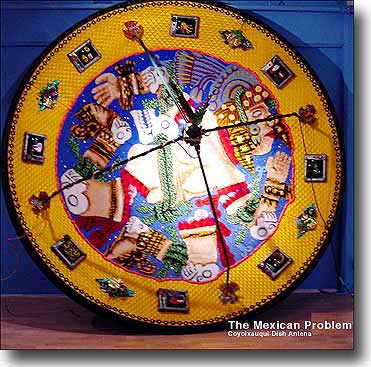Museo de las Artes, Universidad de Guadalajara,
Jan 31, 2002 - Mar 31, 2002
Guadalajara, Jalisco, Mexico
Aesthetic Dissolution? The unique case of the çWe are Oneç duo, where the sum of two thinking brains is greater than one bleeding heart
by Felipe Ehrenberg
Let’s recapitulate, if you insist, your Honor. We can agree that nowadays things are no longer so simple. No, sir, you and I and all of us here in this court are plainly in the Hybrid Age. We are conducting this trial according to Roman Law following the Anglo Saxon Common Law model; my computer talks to me in Spanish, English and Portuguese at the same time; social mores are a blend of rites in which Santa Claus can wear a thong, sarong or kimono; we eat sushi with capers and chimichurri, and almost nothing that shines is gold. Another example is art and its concepts. The principal, your Honor, of "Art being unique and universal" has fallen. Count the years that have gone by since artists went all out for Modernism and struck down the bastions of High Art, in the times of Café Voltaire and the Xalapa movement of List Arzubide and the Stridentists. And how the reaction balked! Does anyone still remember Clement Greenberg and the cocky text he published around 1939, entitled Avant-garde and kitsch?(1) Does anyone recall his indignation when he claimed that jazz, publicity, commercial designing (now called graphic design), Hollywood movies and each and every other expression of the majority taste were no more than formulas for "precarious experiences" and "false sensations?" But gee, there is always someone who will insist on this very same idea. Ladies and gentlemen of the jury, take into account the evidence. It was at the beginning of the sixties, during the Cold War. Critics on both sides of the Atlantic had sequestered Modernism to enthrone their own vanguard; in other words, to market it to insufferable pendants (oh, but how they valued it). Fed up with the situation, Richard Hamilton raised his turned fist before the establishment with his middle finger standing tall and exhibited a modest collage that reflected the feelings of Western artists. Almost unwittingly this gesture led us to Pop. After twenty-five years with its Warholes, Liechtensteins, Wesselmans, Hockneys, and so on, the movement had mutated and was then called Camp.(2) This, and the conceptual stage in which art was submerged in almost the whole world overthrew any notion left about what is "culture" and what is "popular." Art today is no longer plastic but visual and it seems laughable to us to apply those criteria to distinguish "good" from "bad" (left up to the general public to decide what paradigms they prefer, the matter becomes a problem for experts who would rather hang on to their monopoly on taste).
|









